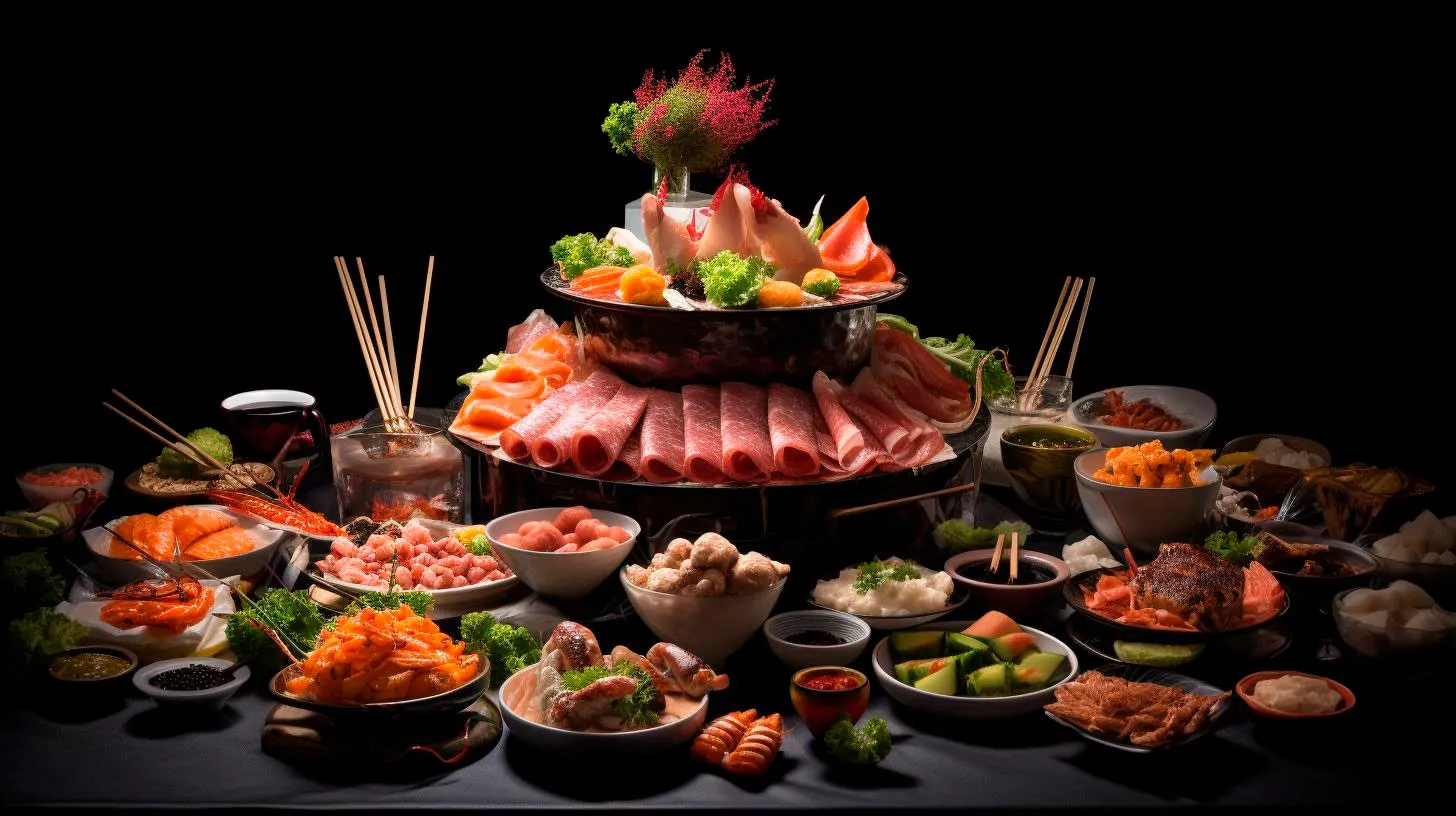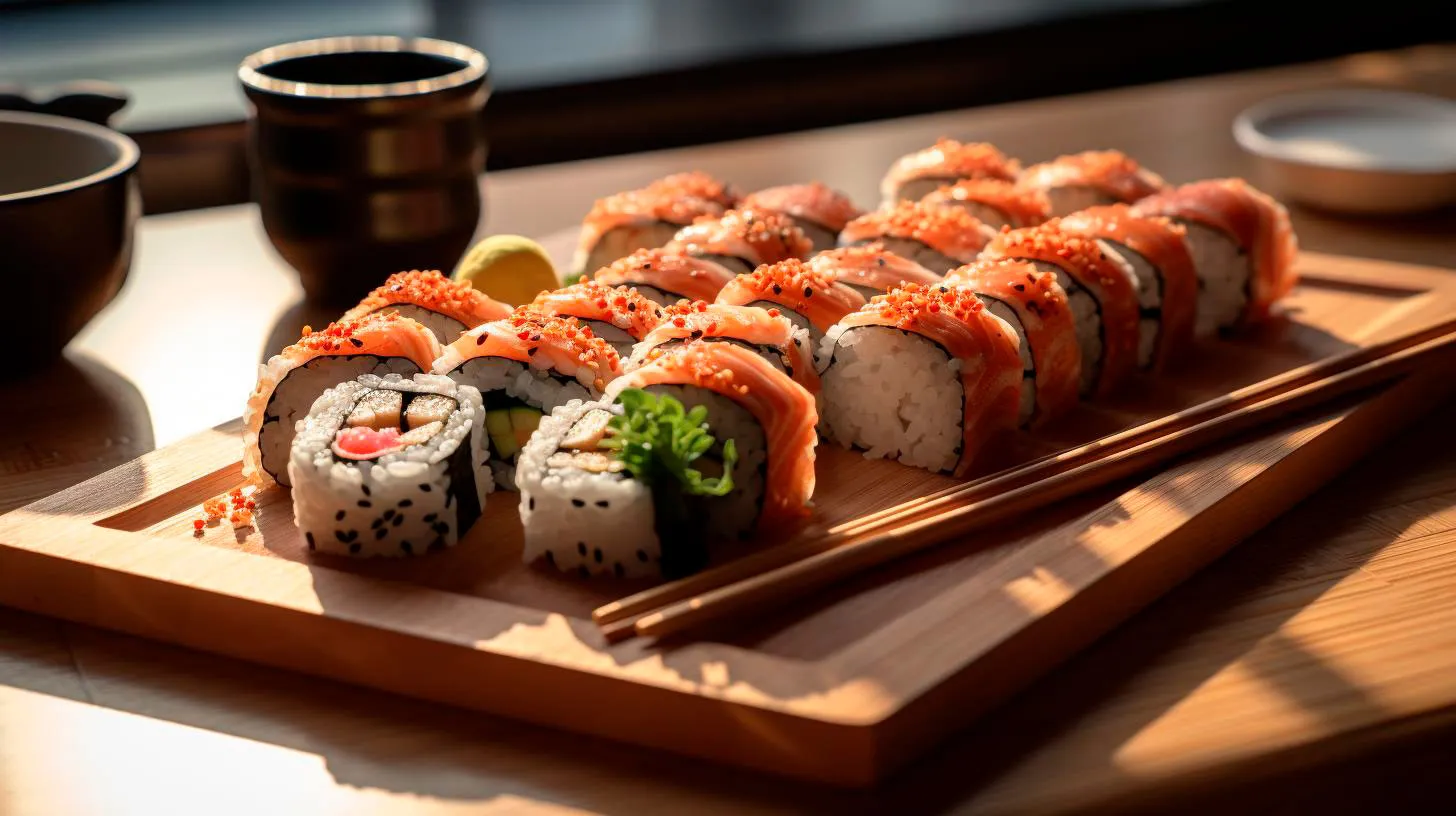The Basics of Nigiri Sushi Rice
In this article, we will delve into the basics of nigiri sushi rice, including its preparation, characteristics, and key tips for achieving the perfect sushi rice.
Understanding Nigiri Sushi Rice
Nigiri sushi rice, commonly known as “shari,” plays a vital role in creating the perfect balance of flavors and textures in nigiri sushi. This rice is not your typical everyday rice; it requires specific handling and seasoning to attain the desired stickiness and tanginess that complement the other ingredients.
Here are some of the key characteristics of nigiri sushi rice:
- Short-grain rice: The ideal rice for nigiri sushi is short-grain rice, which has a higher starch content, providing stickiness and a soft texture.
- Vinegar seasoning: Nigiri sushi rice is seasoned with a mixture of rice vinegar, sugar, and salt. This seasoning adds a delicate tanginess that enhances the overall taste of the sushi.
- Proper consistency: The rice should be cooked to perfection so that it is neither too soft nor too firm. It should hold its shape and have a slightly sticky texture that allows it to adhere to the toppings.
Preparing Nigiri Sushi Rice
Creating the perfect nigiri sushi rice requires careful attention to detail. Here is a step-by-step guide to preparing nigiri sushi rice:
- Wash the rice: Rinse the rice under cold water until the water runs clear. This removes excess starch and ensures a fluffy final product.
- Cook the rice: Add the washed rice and the appropriate amount of water to a rice cooker or pot. Cook according to the manufacturer’s instructions or until the rice is tender.
- Vinegar seasoning: In a separate small bowl, mix rice vinegar, sugar, and salt until dissolved. Once the cooked rice is slightly cooled, gently pour the vinegar mixture over the rice and fold it in using a wooden spatula. Be careful not to overmix, as it can make the rice mushy.
- Cooling and resting: Allow the seasoned rice to cool at room temperature while covering it with a damp cloth or plastic wrap. This resting period allows the flavors to meld and the rice to become slightly sticky.
Tips for Perfect Nigiri Sushi Rice
To elevate your nigiri sushi rice to perfection, keep these tips in mind:
- Choose the right rice: Opt for short-grain rice varieties such as Japanese sushi rice or Calrose rice.
- Measuring the water: Use the appropriate water-to-rice ratio recommended by the rice manufacturer to ensure properly cooked rice.
- Be gentle: When mixing the vinegar seasoning, fold it into the rice gently to avoid breaking the grains.
- Cooling time: Allowing the rice to cool and rest for around 10-15 minutes after seasoning enhances its stickiness and flavor.
- Consistent portioning: When shaping the rice for nigiri sushi, make sure to maintain consistent portion sizes to ensure uniformity in appearance and taste.
Key Takeaways
Nigiri sushi rice is the foundation of a delicious and authentic sushi experience. Understanding its characteristics and mastering the art of preparing it are crucial steps in creating outstanding nigiri sushi. Remember these key takeaways:
- Nigiri sushi rice requires specific short-grain rice and vinegar seasoning for the ideal texture and taste.
- Properly washing and cooking the rice is fundamental to achieving the desired consistency.
- The cooling and resting period allows the rice to develop its stickiness and flavor.
- Attention to detail, such as consistent shaping and portioning, contributes to the overall presentation and taste of nigiri sushi.
With these insights and tips, you are now ready to embark on your nigiri sushi-making journey. Enjoy the process of creating this beloved delicacy and savor the delightful flavors that nigiri sushi rice brings to your palate.
How to Achieve the Perfect Texture for Nigiri Sushi Rice
Why is the Texture of Sushi Rice Important?
Before delving into the process of achieving the perfect texture for nigiri sushi rice, it’s essential to understand why texture matters. The texture of sushi rice significantly impacts the overall sushi-eating experience. Properly cooked rice provides a delicate and slightly sticky consistency, which helps the rice hold its shape when forming nigiri. It allows the ingredients to adhere to the rice, ensuring a pleasant texture and flavor combination in every bite.
The Steps to Achieve the Perfect Nigiri Sushi Rice Texture
1. Choose the Right Rice
The first step in achieving the perfect texture for nigiri sushi rice is selecting the right type of rice. Opt for short-grain Japanese rice, which has a higher starch content, helping to create that desired stickiness. High-quality rice brands such as Koshihikari or Calrose are excellent choices that will yield the best results.
2. Rinse the Rice
Rinsing the rice is a crucial step in removing excess starch, which can result in mushy or clumpy rice. Place the rice in a sieve or fine-mesh strainer and rinse it thoroughly under cold water. Keep rinsing until the water runs clear, indicating that most of the excess starch has been removed.
3. Soak the Rice
After rinsing, allow the rice to soak in water for approximately 30 minutes. This step ensures that the rice grains absorb enough water, resulting in even cooking.
4. Cook the Rice
Once the rice has soaked, transfer it to a heavy-bottomed pot. Add the appropriate amount of water, using a ratio of 1:1 for short-grain rice. Bring the pot to a boil, then reduce the heat to low, cover, and let it simmer for about 15 minutes. Avoid lifting the lid during this process as it can interfere with the rice’s cooking and result in uneven texture.
5. Let the Rice Rest
After cooking, turn off the heat and let the rice rest, still covered, for an additional 10 minutes. This step allows the rice to steam and ensures that each grain achieves the perfect texture.
6. Season the Rice
After the resting period, transfer the cooked rice to a large, shallow wooden bowl. Drizzle the seasoned rice vinegar mixture gently over the rice while using a slicing motion to fold it into the grains. Be mindful not to crush or mash the rice. This step adds flavor to the rice while helping it maintain its stickiness.
7. Fan the Rice
Next, fan the rice gently using a handheld fan, or a piece of cardboard, while simultaneously using a rice paddle to mix and remove excess moisture. This process helps to cool down the rice and achieve the perfect temperature and texture for nigiri sushi rice.
Key Takeaways
- Select high-quality, short-grain Japanese rice for the best results.
- Rinse the rice thoroughly to remove excess starch.
- Soak the rice before cooking to ensure even water absorption.
- Cook the rice on low heat to achieve a tender and fluffy texture.
- Allow the rice to rest before seasoning it with rice vinegar.
- Use a gentle folding motion to incorporate the vinegar into the rice.
- Fan the rice to cool it down and achieve the desired texture.
By following these steps, you can achieve the perfect texture for nigiri sushi rice, elevating your sushi-making skills and impressing your guests. Remember, practice makes perfect, so don’t be afraid to experiment and adjust the process to suit your preferences. Enjoy the satisfying experience of creating delicious nigiri sushi with the ideal rice texture!
Tips and Tricks for Cooking Nigiri Sushi Rice
The success of nigiri sushi heavily relies on the quality and texture of the sushi rice. In this blog post, we will discuss some useful tips and tricks for cooking nigiri sushi rice that will help you achieve that perfect, restaurant-quality taste right at home.
Why Is Sushi Rice Important?
Before we dive into the tips and tricks, let’s understand why sushi rice is such a crucial element in nigiri sushi. The secret lies in the balance of flavors and textures. Sushi rice, or shari, should have a slightly sweet, tangy taste and a soft, sticky texture. This allows the rice to hold its shape and provide a solid base for the toppings while complementing the flavors of the fish or other ingredients.
Tips for Perfect Nigiri Sushi Rice
1. Choose the Right Rice
The type of rice you use plays a crucial role in the outcome of your sushi rice. Opt for short-grain rice, which has a higher starch content. The higher starch content helps achieve a stickier texture, making it easier to shape the rice into mounds.
2. Rinse the Rice
Prior to cooking, rinsing the rice is essential to remove excess starch. This prevents the rice from becoming too clumpy. Place the rice in a fine-mesh strainer and rinse under cold water until the water runs clear.
3. Get the Right Water-to-Rice Ratio
For perfectly cooked sushi rice, it’s important to get the water-to-rice ratio right. A general rule of thumb is to use 1 cup of rice to 1 ¼ cups of water. However, different rice brands may require slight adjustments, so refer to the package instructions for best results.
4. Cook in a Rice Cooker or on the Stove
There are two main methods for cooking sushi rice: using a rice cooker or cooking it on the stove. Both methods can yield excellent results. If using a rice cooker, simply follow the manufacturer’s instructions. If cooking on the stove, bring the rinsed rice and water to a boil, then reduce the heat to low, cover, and simmer for about 15-20 minutes.
5. Use Sushi Seasoning
Once the rice is cooked, transfer it to a large, flat container, preferably wooden or ceramic. Sprinkle sushi seasoning over the rice and gently mix it in using a wooden spatula. Sushi seasoning is a combination of rice vinegar, sugar, and salt, which adds the sweet tanginess essential for sushi rice.
6. Fan the Rice to Cool
After seasoning, fanning the rice helps cool it down while removing excess moisture. Use a handheld fan or a fanning utensil while gently mixing the rice with a cutting motion. This process gives the rice a glossy appearance and helps avoid clumps.
Key Takeaways
- Choose short-grain rice with a higher starch content for better texture.
- Rinse the rice before cooking to remove excess starch.
- Get the water-to-rice ratio right for perfectly cooked rice.
- Consider using a rice cooker or cook on the stove.
- Add sushi seasoning to achieve the desired sweet and tangy flavor.
- Fan the rice to cool it down and give it a glossy appearance.
By following these tips and tricks for cooking nigiri sushi rice, you can elevate your sushi-making skills and create delightful sushi creations in the comfort of your own kitchen. Remember, practice makes perfect, so don’t be discouraged if your first attempt isn’t flawless. With time and practice, you will master the art of cooking perfect nigiri sushi rice and impress your family and friends with your culinary expertise.
Do you have any other tips or tricks for cooking nigiri sushi rice? Share your thoughts and experiences with us in the comments below!
Secret Ingredients to Elevate Your Nigiri Sushi Rice
In this article, we will uncover the secret ingredients to elevate your nigiri sushi rice to the next level, ensuring a mouth-watering and authentic taste.
1. The Rice Variety
Choosing the right rice variety is paramount in achieving the perfect texture and taste for your nigiri sushi rice. Traditional Japanese short-grain rice, such as Koshihikari or Calrose, is commonly used due to its sticky yet fluffy nature. Short-grain rice retains moisture and holds its shape when molded, making it ideal for nigiri sushi.
Key Takeaway:
- Opt for traditional short-grain rice varieties like Koshihikari and Calrose for the best nigiri sushi rice.
2. The Rice Washing Process
Properly washing the rice is a crucial step in sushi rice preparation. The washing process removes excess starch, resulting in a cleaner taste and preventing the rice from becoming sticky or mushy. Rinse the rice under cold water until the water runs clear, usually around three to four times.
Key Takeaway:
- Thoroughly wash the rice to remove excess starch, ensuring a cleaner taste and perfect texture.
3. The Vinegar Mixture
A well-balanced vinegar mixture is essential for achieving the authentic flavor of nigiri sushi rice. To make the perfect vinegar mixture, combine rice vinegar, sugar, and salt. Using high-quality rice vinegar enhances the overall taste. The sugar adds a subtle sweetness, while salt brings out the richness of the rice.
Key Takeaway:
- Create a vinegar mixture with the right balance of rice vinegar, sugar, and salt to enhance the taste of your nigiri sushi rice.
4. Sushi Rice Seasoning
After cooking the rice, it’s time to season it with the vinegar mixture. While the rice is still hot, gently fold in the seasoned vinegar mixture using a wooden spatula or fork. This process coats each grain of rice evenly, giving it a well-rounded flavor.
Key Takeaway:
- Season the rice with the vinegar mixture while it is still hot, ensuring every grain is evenly flavored.
5. Proper Cooling and Storage
After seasoning the rice, allow it to cool to room temperature before using it for nigiri sushi. This step prevents the rice from becoming mushy and helps it retain its shape when forming the sushi. It is essential to store the rice properly by covering it with a damp cloth to prevent it from drying out.
Key Takeaway:
- Cool the rice to room temperature before using it for nigiri sushi, and store it properly by covering it with a damp cloth.
Now that you know the secret ingredients and steps to elevate your nigiri sushi rice, let’s explore why it matters. Using high-quality rice varieties and mastering the preparation techniques will make a noticeable difference in your sushi experience.
Not only does proper preparation enhance the taste and texture, but it also ensures your nigiri sushi holds its shape, allowing for easy and enjoyable consumption. When your sushi rice is perfected, it serves as the ideal canvas for showcasing the freshest and highest-quality fish and other toppings.
Remember, practice makes perfect. It may take a few tries to get the perfect balance of flavors, but with time and dedication, you’ll soon be able to create nigiri sushi rice that rivals the professionals.
So, gather your ingredients, put your newfound knowledge into action, and prepare to impress your family and friends with your elevated nigiri sushi rice. Happy cooking!


